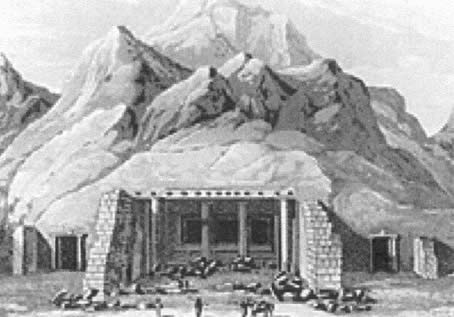
"Mr. Cailliaud in his pursuit of mines in this country happened to reach Sakial-Minor, situated in a valley, a few miles south from Mount Zabara...It is a valley surrounded by high rocks. The rocks of this place resemble an amphi-theatre in form...The upper part of the rocks contains several mines of the ancients..."
Giovanni Belzoni
Narrative of the Operations and Recent Discoveries within Pyramids, Temples, Tombs, and Excavations in Egypt and Nubia (1820)

The big temple of Sikait as depicted by Cailliaud
In 1816 Mohammed Ali, ruler of Egypt, sent the young French mineralogist F. Cailliaud to the Eastern Desert to look for profitable ancient sulphur mines. Cailliaud found the mines exhausted, but his knowledge of ancient literature brought him to Gebel Zabara, the legendary Smaragdus Mons (Emerald Mountain) in the classic texts. His enthusiastic report and a handful of emeralds convinced the Pasha to sent Cailliaud back, this time with a group of miners and a military escort. In December 1817 the young Frenchman found south of Gebel Zabara a deserted ancient town. The mining operation turned out to be a failure and was halted within a year, but the news of the discovery of the ancient town, wrongly identified by some people as Berenike, provoked a sceptical Belzoni to search for the real Berenike. The Italian explorer and archaeologist Belzoni visited Cailliaud's ancient settlement in October 1818, just days before his discovery of Berenike, and identified it as the mining town of Sikait.